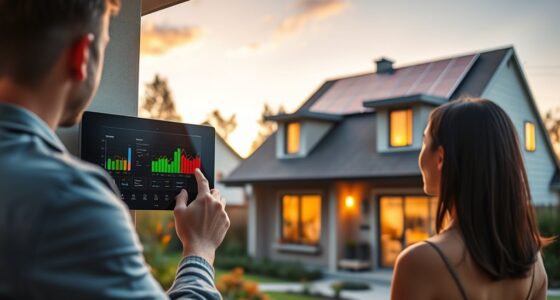Solar windows and BIPV let you turn your building’s exterior into a power plant by integrating photovoltaic materials directly into glass and construction materials. This technology captures sunlight, generates electricity, and helps regulate indoor temperatures without sacrificing natural light or aesthetics. It reduces reliance on external energy sources and lowers operational costs. As innovations improve efficiency and affordability, your building can become a sustainable, energy-producing space—discover more about how this transformation is possible.
Key Takeaways
- Solar windows and BIPV integrate photovoltaic materials into building envelopes, transforming buildings into self-sustaining power sources.
- They replace traditional materials, maintaining aesthetics while actively generating electricity and enhancing energy efficiency.
- BIPV systems reduce energy costs by providing insulation and minimizing energy losses compared to conventional solar panels.
- These technologies are adaptable to various architectural styles, suitable for new builds and renovations with customizable designs.
- Advancements in photovoltaic efficiency and affordability promote sustainable urban development and energy independence.

Have you ever considered how your windows could do more than just let in light? Imagine windows that actively contribute to your building’s energy needs while seamlessly blending into its design. Solar windows and Building Integrated Photovoltaics (BIPV) are transforming the way we think about architecture and energy generation. Instead of traditional windows that simply admit daylight, these innovative solutions incorporate photovoltaic materials directly into the glass, enabling your building to produce electricity without sacrificing aesthetics or functionality. This integration creates a synergy between building design and energy production, making your structure more sustainable and cost-effective.
Building integration is at the core of solar windows and BIPV technology. These systems are designed to be part of the building envelope, replacing conventional materials with multifunctional alternatives. When you opt for solar windows, you’re not just installing ordinary glass; you’re choosing a material that captures sunlight and converts it into usable power. This seamless integration means your building can generate electricity while maintaining natural daylight, reducing dependence on external power sources and lowering energy bills. Over time, this contributes profoundly to the overall energy efficiency of your property, especially in urban environments where space for traditional solar panels might be limited.
Building-integrated solar solutions seamlessly convert sunlight into energy while maintaining natural daylight and sleek design.
Energy efficiency is a key benefit of solar windows and BIPV systems. By integrating photovoltaic materials directly into the building’s structure, you minimize energy losses associated with traditional solar panel installations, which often require additional mounting systems and space. These windows help regulate indoor temperatures by acting as insulators, reducing the need for heating and cooling. With smart design and advanced materials, they can optimize sunlight absorption and minimize glare, creating a more comfortable indoor environment. As a result, your building becomes a self-sustaining energy hub, reducing your carbon footprint and operational costs. Additionally, the development of quantum computing advancements is expected to further enhance the efficiency and capabilities of photovoltaic materials used in BIPV systems.
Furthermore, solar windows and BIPV systems are adaptable to various architectural styles and building types, making them a versatile choice for new constructions or renovations. They can be customized to fit specific aesthetic or functional requirements while delivering maximum energy gain. With ongoing advancements in photovoltaic technology, these solutions are becoming more affordable and efficient, making widespread adoption more practical than ever. By choosing solar windows, you’re not only investing in a sleek, modern look but also actively participating in a sustainable future—turning your building into a mini power plant that produces clean energy around the clock.
Frequently Asked Questions
What Are the Current Costs of Installing Solar Windows and BIPV Systems?
You might wonder about the cost comparison for solar windows and BIPV systems today. Currently, these systems can range from $200 to $600 per square meter, depending on technology and installation complexity. Market trends show prices are gradually decreasing as production scales up and new innovations emerge. While initial costs are higher than traditional windows, they offer long-term savings on energy, making them an increasingly attractive choice for eco-conscious building owners.
How Long Do Solar Windows and BIPV Panels Typically Last?
Imagine a building’s facade like a resilient fortress. Solar windows and BIPV panels usually undergo durability testing to make certain they withstand weather and wear. Typically, they have a lifespan estimation of 25 to 30 years, comparable to other durable building materials. With proper maintenance, you can expect these systems to last decades, making them a reliable investment that turns your building into a long-lasting power generator.
Are There Any Aesthetic or Design Limitations With Solar Windows?
You might wonder if solar windows limit your building’s design. While they do require good architectural integration, advancements now offer more color options to match your aesthetic. However, some designs may be constrained by the need to optimize solar efficiency, potentially impacting the visual harmony. Still, manufacturers are increasingly focusing on seamless integration, so you can enjoy energy benefits without sacrificing style.
What Maintenance Is Required for Solar Windows and BIPV Systems?
Maintenance might seem mundane, but it matters. You’ll want to follow simple cleaning protocols to keep surfaces sparkling and maximize efficiency. Regular system inspections help spot potential problems before they worsen. By sticking to these straightforward schedules, you ensure your solar windows and BIPV systems stay at peak performance, prolonging their lifespan and powering your building sustainably. Proper upkeep keeps your investment in energy excellence ongoing and effective.
How Do Solar Windows Perform in Different Climate Conditions?
You might wonder how solar windows perform in different climate conditions. They’re designed with climate adaptability in mind, but efficiency variations can occur based on factors like temperature, sunlight, and humidity. In colder or overcast environments, their energy output might decrease, while sunnier, milder climates enhance performance. Overall, modern solar windows are engineered to maintain supreme efficiency across diverse conditions, making them a versatile choice for turning buildings into power plants.
Conclusion
By embracing solar windows and BIPV technology, you can transform buildings into efficient power generators. Imagine a skyscraper in New York replacing its conventional glass with solar windows, generating enough electricity to power its entire operations. This approach not only reduces your carbon footprint but also cuts energy costs. As more buildings adopt this innovative approach, you play a crucial role in shaping a sustainable future—turning urban landscapes into thriving, clean energy hubs.









